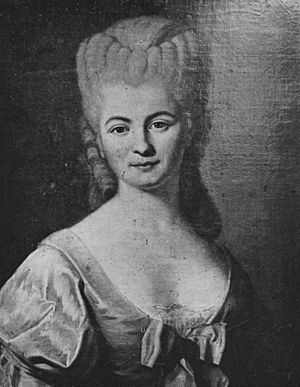Nicole-Reine Lepaute facts for kids
Nicole-Reine Lepaute (born Étable de la Briere; January 5, 1723 – December 6, 1788) was a smart French astronomer and mathematician. She is famous for helping to predict when Halley's Comet would return. She worked with other scientists like Alexis Clairaut and Joseph Lalande. They also calculated the timing of a solar eclipse and made important star catalogs.
An asteroid called 7720 Lepaute and a crater on the Moon are named after her. She was also part of the Scientific Academy of Béziers.
Contents
Biography
Nicole-Reine Lepaute was born in Paris on January 5, 1723. Her father, Jean Étable, worked for the royal family. She was one of nine children. Even as a child, she was very bright and loved to learn. She taught herself a lot by reading books all night long.
In August 1749, she married Jean-André Lepaute. He was a famous royal clockmaker. His clocks were known all over Europe for being very special.
Early Work with Clocks
Nicole Lepaute worked with her husband to build a special clock. This clock could also show astronomical information. She suggested the idea and helped build it. In 1753, they showed the clock to the French Academy of Science. It was approved by Jérôme Lalande, a famous astronomer.
After this, she worked with her husband and Lalande on a book about clockmaking. It was called "Traite d'horlogerie" (Treatise of Clockmaking). The book was published in 1775 under her husband's name. Even though she wasn't listed as an author, Lalande praised her work. He said she calculated many important tables for the book.
Predicting Halley's Comet
Jérôme Lalande asked Nicole Lepaute and mathematician Alexis Clairaut for help. Their big task was to predict when Halley's Comet would return. They also had to figure out how the gravity of Jupiter and Saturn would affect the comet.
The team worked very hard for more than six months. They barely stopped, even for food! In November 1758, they announced their prediction. They said the comet would arrive on April 13, 1759. They were almost perfectly right! The comet actually arrived on March 13, 1759.
This was a huge achievement. It was the first time scientists had successfully predicted when a comet would reach its closest point to the Sun. This point is called the perihelion. Sadly, Clairaut did not give Nicole Lepaute credit for her work. This upset Lalande, who thought she was "the most distinguished female French astronomer ever." He made sure to acknowledge her help in his own writings.
More Achievements in Math and Astronomy
In 1759, Nicole Lepaute joined Lalande's team again. They worked together to calculate the ephemeris for the transit of Venus. An ephemeris is like a calendar that tells you where planets and stars will be in the sky.
In 1761, she was recognized for her skills. She became an honorary member of the Scientific Academy of Béziers. For fifteen years, Lalande and Lepaute worked together on annual guides for astronomers and sailors. These guides included detailed ephemerides. After her death, Lalande wrote a short biography about her important contributions to astronomy.
In 1762, Lepaute calculated the exact time of a solar eclipse that happened on April 1, 1764. She wrote an article about it. It included a map showing where the eclipse would be seen across Europe. She also predicted the time and how much of the Sun would be covered in different areas. This article was published in Connaissance des Temps (Knowledge of the Times). She also created important catalogs of stars that helped future astronomers. She calculated the ephemeris for the Sun, Moon, and planets for many years, from 1774 to 1784.
Personal Life
Nicole Lepaute did not have her own children. But in 1768, she adopted her husband's nephew, Joseph Lepaute Dagelet. She taught him astronomy and advanced mathematics. He learned so well that he became a math professor at a French military school at age 26. Later, he became an astronomer at the French Royal Academy of Sciences.
Nicole Lepaute took care of her husband, who was very ill, from 1767 until her own death. She passed away in Paris on December 6, 1788. She had lost her eyesight just a few months before.
See also
 In Spanish: Nicole-Reine Lepaute para niños
In Spanish: Nicole-Reine Lepaute para niños


